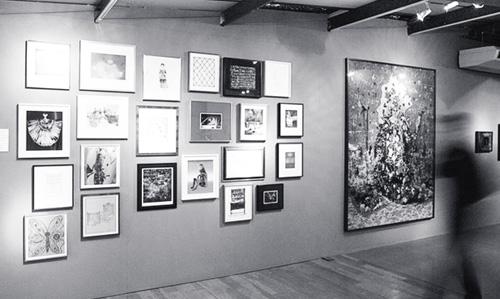为什么要收藏艺术品
2018-06-12ByErinThompson
By Erin Thompson

The oil billionaire J. Paul Getty was famously miserly.1 Yet he spent millions of dollars on art, and millions more to build the Getty Museum2 in Los Angeles. He called himself “an apparently incurable artcollecting addict”, and noted that he had vowed to stop collecting several times, only to suffer “massive relapses”.3 Fearful of airplanes and too busy to take the time to sail to California from his adopted hometown of London, he never even visited the museum his money had filled.
Getty is only one of the many people through history who have gone to great lengths to collect art—searching, spending, and even stealing to satisfy their cravings.4 But what motivates these collectors?
Debates about why people collect art date back at least to the first century CE5. The Roman rhetorician Quintilian claimed that those who professed to admire what he considered to be the primitive works of the painter Polygnotus were motivated by “an ostentatious desire to seem persons of superior taste”.6 Quintilians view still finds many supporters.
Another popular explanation for collecting—financial gain—cannot explain why collectors go to such lengths. Of course, many people buy art for financial reasons. You can resell works, sometimes reaping7 enormous profit. You can get large tax deductions8 for donating art to museums. More nefariously, some “collectors” buy art as a form of money laundering, since it is far easier to move art than cash between countries without scrutiny.9
But most collectors have little regard for profit. For them, art is important for other reasons. The best way to understand the underlying drive of art collecting is as a means to create and strengthen social bonds, and as a way for collectors to communicate information about themselves and the world within these new networks.10
People tend to imagine collectors as highly competitive, but that can prove wrong too. Serious art collectors often talk about the importance not of competition but of the social networks and bonds with family, friends, scholars, visitors and fellow collectors created and strengthened by their collecting. The way in which collectors describe their first purchases often reveals the central role of the social element. Only very rarely do collectors attribute their collecting to a solo encounter with an artwork, or curiosity about the past, or the reading of a textual source.11 Instead, they almost uniformly give credit to a friend or family member for sparking their interest,12 usually through encountering and discussing a specific artwork together.
Collectors are not only interested in creating social links; they are also motivated by the messages they can send once these social networks are created. We all know that art is a powerful way for the artist to express thoughts and feelings—but collectors know that art can serve as an expressive vehicle for collectors too. Many thus carefully curate their collections, purchasing only artworks whose display backs up a claim that the collector wishes to make.13
Almost always, this claim is about the identity of the collector. Displaying art can send a message about who the collector really is—at least who she sees herself as. From the beginning of art-making, we have believed that artworks capture and preserve the essence of their makers and even their owners. As identity can derive from lineage14, owning artworks is therefore also a way for an owner to communicate with the past.
Other art collectors see their collections as having a broader power—to convey messages not just about themselves, but about the world as a whole. For example, the kid with the shoebox of bird feathers might show others her collection not just to make friends, but also to convince them about the importance of protecting endangered species.
But there is also a downside15. Sometimes, collectorsfeelings about the purpose of their collections were so strong that they become one of the most important participants of the illicit trade in looted antiquities.16 To address the problem, it involves effectively convincing collectors that their past conduct, something they have almost certainly understood as an expression of their best possible self, their highest aspirations, has actually been harmful.17 It means, in effect, repudiating18 the bonds they have formed with other collectors. And, as Getty was hardly the first or the last to discover, that is a hard addiction indeed to overcome.

1. J. Paul Getty: 保罗·盖蒂(1892—1976),美国石油大亨,盖蒂石油公司创始人,1957年被《财富》杂志誉为“最富有的美国人”,1966年被《吉尼斯世界纪录》评为世界首富;miserly: 吝啬的。
2. Getty Museum: 盖蒂博物馆,一座位于美国加州洛杉矶的艺术博物馆,拥有两个馆址:盖蒂中心和盖蒂别墅。前者收藏中世纪以来的西方艺术品,后者展出古希腊、罗马时期以来的艺术品。
3. 他把自己称作“一位显然已经无药可救的艺术收藏瘾君子”,还说他好几次都发誓要戒掉,但结果总是“舊病复发”。relapse:故态复萌,回到原状。
4. go to great length to do: 付出很多努力以达到目标;craving: 渴望,渴求。
5. CE: 基督纪元,公元。
6. 罗马修辞家昆提利安认为,有些人声称自己很欣赏画家波利格诺托斯的那些在他看来很古老的作品,而这些人不过是“故意卖弄、附庸风雅”罢了。rhetorician:修辞家;Quintilian: 昆提利安(约公元35—100年),古罗马帝国时期著名修辞家、教育家、作家等,他的教育理论受到15、16世纪的人文主义者的重视,并对现代教育观点影响很大;profess:公开声称,宣称;primitive: 原始的,简单的;Polygnotus: 波利格诺托斯,公元前5世纪古希腊雕刻家,著有《典范》(Canon),强调人体美学;ostentatious:卖弄的,炫耀的。
7. reap: 收获,得到。
8. deduction: 扣除,减少,tax deduction表示“减税”。
9. nefariously: // 恶毒地,充满恶意地;money laundering: 洗钱;scrutiny: 密切关注,严格审查。
10. 要想解释艺术收藏的根本原因,最好的说法就是这是一个构建并加强社会关系的途径,同时也是新的交流方式,收藏家们可以通过这种方式表达他们对于自己和世界的种种看法。
11. 很少有收藏家会把收藏艺术品归因于偶然看见一件艺术品、对过去的好奇,或是读了一些文字资料。attribute...to:把……归因于,认为……出自……。
12. give credit to: 给……(应得的)赞扬、感谢;spark: 引发,启发。
13. 因此很多收藏家都会谨慎挑选自己的藏品,只会为那些能展现他们想法的艺术作品买单。curate:策展,管理藏品。
14. lineage: 家系,血统。
15. downside: 负面影响。
16. illicit: 违法的,违禁的;loot: 抢劫,掠夺。
17. 要解决这个问题,就必须有力地说服这些收藏家,让他们明白虽然他们几乎会把过去这些行为当做最好的自我以及最高理想的表达,但这些行为其实是有害无益的。
18. repudiate: 否认,拒绝承认。
